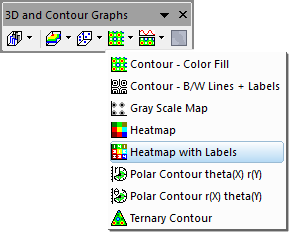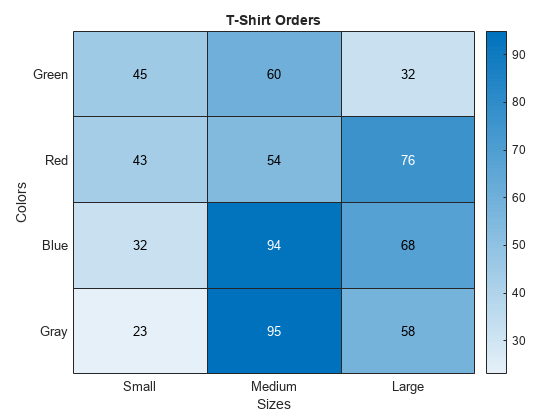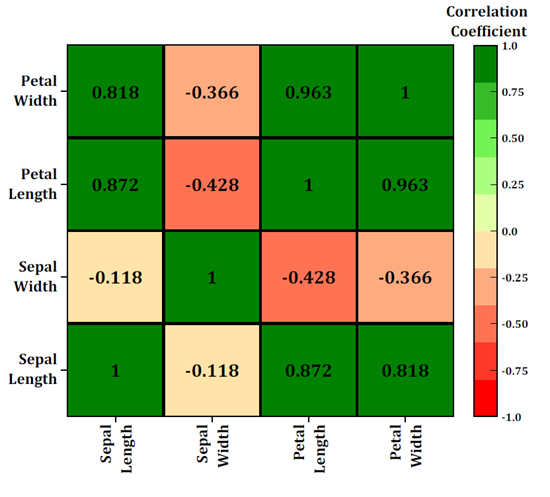41 heatmap 2 column labels on top
Chapter 3 Heatmap Annotations | ComplexHeatmap Complete Reference Heatmap(matrix(rnorm(100), 10), name = "mat", top_annotation = HeatmapAnnotation(foo = anno_block(gp = gpar(fill = 2:4))), column_km = 3) Labels can be added to each block. Heatmap to display labels for the columns and rows and display the data ... Heatmap to display labels for the columns and rows and display the data in the proper orientation in Matplotlib. ... # Want a more natural, table-like display ax.invert_yaxis() ax.xaxis.tick_top() ax.set_xticklabels(row_labels, minor=False) ax.set_yticklabels(column_labels, minor=False) plt.show() ...
heatmap.2 function - RDocumentation heatmap.2: Enhanced Heat Map Description A heat map is a false color image (basically image (t (x))) with a dendrogram added to the left side and/or to the top. Typically, reordering of the rows and columns according to some set of values (row or column means) within the restrictions imposed by the dendrogram is carried out.

Heatmap 2 column labels on top
A Complete Guide to Heatmaps | Tutorial by Chartio The other common form for heatmap data sets it up in a three-column format. Each cell in the heatmap is associated with one row in the data table. The first two columns specify the 'coordinates' of the heat map cell, while the third column indicates the cell's value. Best practices for using a heatmap Choose an appropriate color palette Seaborn Heatmap using sns.heatmap() | Python Seaborn Tutorial Heatmap using 2D numpy array Creating a numpy array using np.linespace () function from range 1 to 5 with equal space and generate 12 values. Then reshape in 4 x 3 2D array format using np.reshape () function and store in array_2d variable. 1 2 3 array_2d = np.linspace (1,5,12).reshape (4,3) # create numpy 2D array How to include labels in sns heatmap - Data Science Stack Exchange The best answers are voted up and rise to the top Data Science . Home ... But can someone help me how do I include the column and row labels? The column labels and row labels are given (120,100,80,42,etc.) ... sns.heatmap() function has two parameters which are xticklabels for x-axis and yticklabels for y-axis labels. Follow the code snippet ...
Heatmap 2 column labels on top. Display the Pandas DataFrame in Heatmap style - GeeksforGeeks columns = cols, index = idx) df = pd.DataFrame (df, columns =['A', 'B', 'C', 'D']) corr = df.corr () sn.heatmap (corr, annot = True) Output : If the uppermost and the lowermost row of output figure does not appear with proper height then add below two lines after the last line of the above code. bottom, top = ax.get_ylim () Creating annotated heatmaps — Matplotlib 3.5.2 documentation Using the helper function code style#. As discussed in the Coding styles one might want to reuse such code to create some kind of heatmap for different input data and/or on different axes. We create a function that takes the data and the row and column labels as input, and allows arguments that are used to customize the plot seaborn.heatmap — seaborn 0.11.2 documentation - PyData If a Pandas DataFrame is provided, the index/column information will be used to label the columns and rows. vmin, vmaxfloats, optional Values to anchor the colormap, otherwise they are inferred from the data and other keyword arguments. cmapmatplotlib colormap name or object, or list of colors, optional The mapping from data values to color space. heatmap.2 - change column & row locations; angle / rotate Esteemed BioC user's, I'm struggling to achieve some details of a heatmap using heatmap.2(): 1. Change label locations, for both rows & columns from the default right & bottom, to left and top. Can this be done within heatmap.2()?
r - Heatmap.2: add row/column labels on left/top without hard coding ... Heatmap.2: add row/column labels on left/top without hard coding coordinates. I'm trying to recreate a heatmap, using heatmap.2, similar to this (1): I'm able to add the "A C G T" labels to the bottom column and right row labels. I'm trying to add "group" names to the top and left axis ("1012T3" etc. and "G>A" etc). Ultimate Guide to Heatmaps in Seaborn with Python These charts contain all the main components of a heatmap. Fundamentally it is a grid of colored squares where each square, or bin, marks the intersection of the values of two variables which stretch along the horizontal and vertical axes. In this example, these variables are: The hour of the day The minute of the hour R How to build angled column headings above columns in heatmap.2: pass ... pos2 <- locator () #will return plotting coordinates after doing this: # shift focus to the graphics window by clicking on an edge # left-click once where you want the first label to be centered # left-click again on the point where you want the last label centered # right-click, then return focus to the console session window pos2 <- … seaborn.heatmap — seaborn 0.11.2 documentation If True, plot the column names of the dataframe. If False, don’t plot the column names. If list-like, plot these alternate labels as the xticklabels. If an integer, use the column names but plot only every n label. If “auto”, try to densely plot non-overlapping labels. mask bool array or …
How to include labels in sns heatmap - Data Science Stack Exchange The best answers are voted up and rise to the top Data Science . Home ... But can someone help me how do I include the column and row labels? The column labels and row labels are given (120,100,80,42,etc.) ... sns.heatmap() function has two parameters which are xticklabels for x-axis and yticklabels for y-axis labels. Follow the code snippet ... Seaborn Heatmap using sns.heatmap() | Python Seaborn Tutorial Heatmap using 2D numpy array Creating a numpy array using np.linespace () function from range 1 to 5 with equal space and generate 12 values. Then reshape in 4 x 3 2D array format using np.reshape () function and store in array_2d variable. 1 2 3 array_2d = np.linspace (1,5,12).reshape (4,3) # create numpy 2D array A Complete Guide to Heatmaps | Tutorial by Chartio The other common form for heatmap data sets it up in a three-column format. Each cell in the heatmap is associated with one row in the data table. The first two columns specify the 'coordinates' of the heat map cell, while the third column indicates the cell's value. Best practices for using a heatmap Choose an appropriate color palette











Post a Comment for "41 heatmap 2 column labels on top"